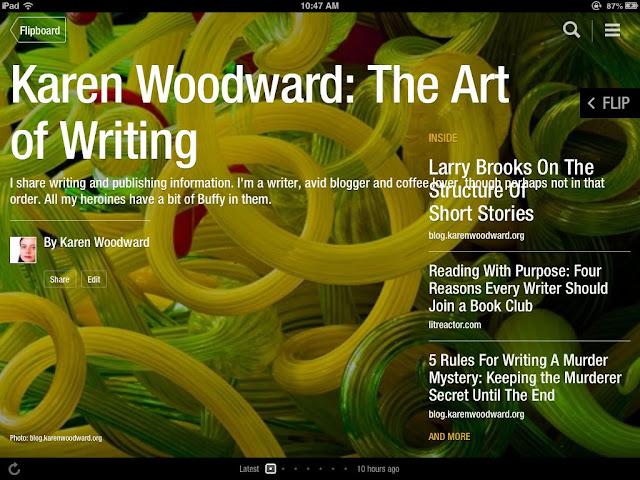
I'm excited! For months I've been looking for a really good sink-your-teeth-in analysis of
short story structure.
Today I found it in Larry Brooks' post:
The Short Story on Structuring Your Short Story.
"short stories are harder to wrap your head around than a novel"
It's so true!
And that seems strange. A novel is 80,000 or so words while a short story can be as brief as 1,000. It would seem that a short story would be
easier, not harder, to write.
Larry Brooks writes:
For every famous short story writer out there, there are 100 famous novelists. That’s no accident.
To help explain this – as much to myself as for those reading this –
consider this analogy: we get about two decades to raise our children.
We have that long, give or take, to send them out into the world with a
shot at success and happiness.
A lot has to happen. Sometimes two decades isn’t enough.
Try doing it in six months. Or even a year.
The Elements of Any Story
Larry Brooks lists the following as essential elements in
any story, regardless of length:
- Conflict
- Stakes
- Need
- Journey
- Opposition
- Characterization
- Setting
- Arena
- Sub-text
- Voice
Your story is like a canvas laid out before you. Perhaps the canvas
is huge and populated with dozens of characters (+120,000 word novels).
Perhaps the canvas is tiny as a postage stamp (flash fiction).
It's up to you what
size
you want the canvas to be (/how maybe words you want to use) but you
still have to communicate the same elements, though you have far less
space and opportunity to do so.
If you're looking at this list wondering how the heck you can get all that into a 1,000 word piece of flash fiction, here's what Larry Brooks says is the trick: One or more of the above can be
implied.
(By the way, Stephen King talks about his book,
Under The Dome, and compares its scope to the size of a painter's canvas. The video clip is 4 minutes 11 seconds long.)
Know Your Theme
Writers need to be crystal clear about their
objective for the story. Larry writes:
To pull this off, the short story writer needs to be perhaps even better at one specific aspect of the storytelling craft than the novelist.
The short story writer needs to be mission-driven. The writer’s intentions – which implies a clear understanding of why this story needs to be written – requires a clear, concise objective before it can work.
In other words, while this isn't always true for novels, for a short story you need to know your theme
before you set pen to paper.
Once you understand the mission of the story--the work you want it to do--then you can decide on what structure you want the story to have.
Larry writes:
And for that [the story's structure], you can use the four-part structure for novels (set-up,
response, attack, resolution, each part separated by specific plot
points) to put a fence around your short story intentions.
The Structure of a Short Story
The question: Does a short story have to be structured like a novel? Does it have to have three acts, two plot points (/reversals), pinch points, and so on?
Larry says no, it's up to you.
Imagine a novel as a house. An 80,000 word novel would be like a 2,500 square foot family home. Perhaps we can compare a 120,000 word high fantasy novel to a sprawling 6,000 square foot manor house.
In larger works, you show the whole house while in a short story you have a choice. You can show a very very small house (friends of mine lived in a 500 square foot thimble of a house while they were going to university) or you can choose to only show one room of a larger house.
Larry writes:
Yes, you can create a four-part short story that is, in essence, a condensed version of the classic structural paradigm.
Or, you can hone in on any specific moment or segment of the
four-part structure – such as, a single plot point element or a single
scene from within any of the four contextually-defined parts – and have that become your architecture.
It’s like building a one room addition next to your house. The end
product might be intended to accommodate anything and everything that
could go in inside the house, and when it’s done it needs to blend into
the aesthetics and structural design of the bigger house.
Even if, in a picture or a drive-by, nobody gets to actually see the larger house.
Brilliant analogy.
The Elements Of Any Story
I'm writing a 1,000 word piece of flash fiction for
Chuck Wendig's Flash Fiction Challenge and it's difficult! So much has to be included but even more has to be left out.
Here, though, are the elements I think any riveting story has:
- At least one character who wants something desperately.
- Clear stakes, what will happen if he succeeds and what will happen if he fails. And not just generally, personally. To him, to the people he loves.
- Made the protagonist's motivation clear. (e.g., motivation vs goal: Frodo took the One Ring to Mordor because he wanted to, basically, save the world from destruction. That was his motivation. His goal was to destroy the ring.)
- One way in which your main character is strong
- One way in which your main character is very weak
- A character who takes decisive action to achieve his goal.
I think the key here is, in the case of flash fiction, that you can show more than one thing at the same time (for example, show a character's weakness at the same time as you show what he wants most in the world).
Story Structure: The Essentials
Jack went to the corner grocery store, lit it on fire, and came home.
That is kinda, sorta, a story. Not a very good one, though. Why did Jack light the store on fire? What did he hope to gain? Was he trying to prevent something? Who is Jack anyway?
There is no cause and effect structure, the events of the story--Jack going to the store, setting the store on fire, and coming back home--seem completely independent of each other; unrelated.
There are certain elements every story should have, which is not to say that every story should have the same structure.
I think Chuck Wendig is right,
every story is unique and so, unsurprisingly, has it's own unique structure. That said, there are certain things gripping stories, riveting stories, the kind of stories that keep you up reading till 3am even when you have an important meeting the next morning ... there are certain elements
those stories have in common. For instance, one of the characters will always want
something and there will be something preventing him/her from achieving it.
But, still, the structure of every single individual story will be unique.
1. A Set-Up/Ordinary World
Call this part what you will, but there needs to be something that came before the inciting incident,
even if that something is never shown in the story. Some stories have the action begin at the inciting incident or after it, but at some point we need to get a peek at what the protagonist's life was like before the call to adventure.
2. Inciting Incident/Call To Adventure
Something happens to break the status quo and offers the hero/protagonist a challenge, a goal to pursue. A course of action which has an endpoint and clear stakes. We need to see:
- How the protagonist reacts to this incident. Is he scared, elated, cocky? What actions does he take in response to this change?
- What are the stakes? What will happen to the hero if he takes up the challenge and achieves the goal/prize? If he fails? (Often there's a
sequel after the scene in which the inciting incident occurs in which the hero discusses his options.)
- What is the heroes goal?
- What is the heroes motivation?
3. Midpoint
Something big needs to happen. This could involve explosions and hand-to-hand combat but it needn't. The essential thing is that the hero confronts or experiences something profound, something that will fundamentally change him or her.
This realization doesn't have to be something big. For instance, sometimes these revelations are like the last domino falling, they can be triggered by gazing out the living room window after the first snowfall of the year. (But of course that will have been built up to.)
When I write/edit, I strive to make it clear how this event, whatever it is that happens at the midpoint, changes the protagonist's goal--if it does. How it changes the stakes. How it causes the opposition to increase.
4. Reversal/All Is Lost/Complications (approx 3/4 mark)
After the midpoint and before the resolution there's probably going to be a big setback or at least a surprising, unexpected, change that complicates things, that makes it much harder--if not impossible--for the hero to attain his goal.
The stakes have been clearly spelled out in the other sections of the story so, here, the hero is staring failure in the face. Whatever plans the hero has, whatever progress they've made, is wiped out--or seems to be wiped out--right at the moment of victory.
But wait! It's so much worse than he thought it would be.
The negative consequences of failure aren't changed, not really, but they are intensified. Whatever the hero was anticipating, the negative stakes are now 10 times worse. If, in the beginning, only the hero's life was in danger, now the lives of his companions (if any), his tribe, and indeed the entire planet (perhaps the galaxy!), hang in the balance.
Now comes the really tricky part, getting the hero out of the mess he's in!
The hero as phoenix
One way of pulling the hero out of both the fire and the frying pan is to use his weakness. By overcoming his weakness, his great flaw, he will discover a way around the obstacles before him, a way to achieve his goal.
Or perhaps your hero has a special strength. For example, Indiana Jones had both knowledge and control--he knew not to look at the Ark when the Nazis opened it and, because (unlike Pandora) he could control his curiosity, he survived their fate.
The important thing is that if the hero does save himself at the 11th hour
how he does it should come as a surprise, but one the audience feels they should have seen, or at least one that they could have worked out for themselves if they'd had more time to think about it.
5. Resolution
This is the climax, the final confrontation. This is where the hero either achieves his goal or fails.
Whichever outcome, we need to show the aftermath.
- The hero realizing the stakes, either victory or defeat. We needed to see Frodo back on The Shire. We need to see the One Ring slip into the liquid fire.
- Show the effect of victory or defeat on whatever it was that motivated him.
- Show what happened to whatever opposed the hero in his quest.
And in flash fiction you have to try and do the essential bits in the above in under 1,000 words!
Challenge: I'm taking up Chuck Wendig's Flash Fiction challenge this week. Join me! Which sentence would you pick as the first line of your 1,000 word story?
Other articles you might like:
-
How To Get Honest Book Reviews
-
What Slush Pile Readers Look For In A Story
-
Is Writing Rewriting?
Photo credit: "
verde amarelo" by
alexdecarvalho under
Creative Commons Attribution 2.0.










